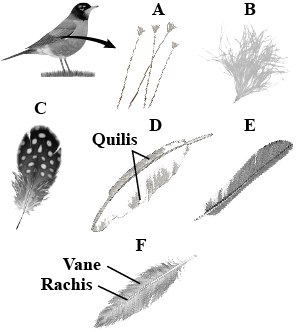Question
Question: Here are the kinds of feathers of a pigeon, match them correctly. A. Rectrice feathers are useful ...
Here are the kinds of feathers of a pigeon, match them correctly.
A. Rectrice feathers are useful in blanching and steering found in the tail of birds.
B. Typical feathers of a bird.
C. Filoplumes are found all over the body.
D. Remige feathers form the wings of birds.
E. Down feathers help in retaining heat and are found all over the body.
F. Contour feathers give streamlined shape to the bird’s body.

I. 1-F, 2-D, 3-A, 4-E, 5-B, 6-C
II. 1-E, 2-F, 3-A, 4-D, 5-B, 6-C
III. 1-C, 2-F, 3-A, 4-E, 5-B, 6-D
IV. 1-D, -F, 3-A, 4-E, 5-B, 6-C
Solution
Pigeons belong to the family Columbidae consisting of several hundred bird species. Pigeons can be found everywhere except in extremely cold regions. Feathers in pigeons are found all over its body. Feathers are variously modified in pigeons to serve different functions.
Complete answer:
Pigeons are a wide number of bird species found almost everywhere, even on the roofs of houses and buildings. The body of pigeons is entirely covered with feathers. Pigeons have variously modified fathers that serve different functions.
The typical components of a pigeon feather are the calamus which is a hollow tubular structure that is inserted into the pigeon’s skin. The second component is rachis which is the terminal longitudinal axis. It is solid and opaque as compared to a calamus. The third component is called vane which is an expanded membranous part of the feather. Barbs are thin longitudinal structures found attached to the calamus in some feather modifications.
Let us discuss each of the feather modifications in detail.
Figure A represents the filoplumes or hair feathers. These are small and delicate feathers. These are hair-like feathers which are present all over the body of the pigeons. It consists of a short calamus and a long rachis which is usually thread-like. Filoplumes have a few weal terminal barbs and barbules with the absence of hamuli.
Figure B represents the down feathers also called plumes. These are small and soft wooly type feathers that lack rachis. They have a short calamus having a fluffy tuft of long barbs having short barbules. These are also called nestling down feathers as they cover the body of a young one. These feathers act as an insulating layer and are present all over the body.
Figure C represents the contour feathers. These are quill feathers that form the general covering of the body. These are small and wooly feathers. They have poorly developed barbules. They provide warmth to the body. Also, they aid in smooth airflow without turbulence. They provide a streamlined shape to the bird’s body.
Figure D represents remige feathers. They occur on the wings and function to provide flight. These are also named pinions or wing quills. These feathers form the wings of the bird.
Figure E represents the retrace feathers. These feathers form the tail of the pigeon. They form a semi-circular or fan-like structure. These feathers act as a brake in lightning. They act as a rudder in vertical and lateral steering. Thus, these are used in blanching and steering.
Figure F feather represents a typical pigeon feather having defined vane and rachis.
So, the correct matching sequence is 1-E, 2-F, 3-A, 4-D, 5-B, 6-C. Hence, option (II) is the correct answer.
Note: The feathers originate from the papillae of the skin of the embryo. Contour feathers and down feathers originate from different sources. The pigeon’s body is pigmented due to pigments present on the feathers. Reflection and diffraction processes also provide coloration to feathers.
